
In angiosperms, a hypanthium or floral cup is a structure where basal portions of the calyx, the corolla, and the stamens form a cup-shaped tube. It is sometimes called a floral tube, a term that is also used for corolla tube and calyx tube. It often contains the nectaries of the plant. It is present in many plant families, although varies in structural dimensions and appearance. This differentiation between the hypanthium in particular species is useful for identification. Some geometric forms are obconic shapes as in toyon, whereas some are saucer-shaped as in Mitella caulescens.

Hummingbirds are birds native to the Americas and comprise the biological family Trochilidae. With approximately 366 species and 113 genera, they occur from Alaska to Tierra del Fuego, but most species are found in Central and South America. As of 2024, 21 hummingbird species are listed as endangered or critically endangered, with numerous species declining in population.

Petals are modified leaves that surround the reproductive parts of flowers. They are often brightly colored or unusually shaped to attract pollinators. All of the petals of a flower are collectively known as the corolla. Petals are usually accompanied by another set of modified leaves called sepals, that collectively form the calyx and lie just beneath the corolla. The calyx and the corolla together make up the perianth, the non-reproductive portion of a flower. When the petals and sepals of a flower are difficult to distinguish, they are collectively called tepals. Examples of plants in which the term tepal is appropriate include genera such as Aloe and Tulipa. Conversely, genera such as Rosa and Phaseolus have well-distinguished sepals and petals. When the undifferentiated tepals resemble petals, they are referred to as "petaloid", as in petaloid monocots, orders of monocots with brightly colored tepals. Since they include Liliales, an alternative name is lilioid monocots.

Passiflora, known also as the passion flowers or passion vines, is a genus of about 550 species of flowering plants, the type genus of the family Passifloraceae.

Heliconia is a genus of flowering plants in the monotypic family Heliconiaceae. Most of the 194 known species are native to the tropical Americas, but a few are indigenous to certain islands of the western Pacific and Maluku in Indonesia. Many species of Heliconia are found in the tropical forests of these regions. Most species are listed as either vulnerable or data deficient by the IUCN Red List of threatened species. Several species are widely cultivated as ornamentals, and a few are naturalized in Florida, Gambia, and Thailand.

Passiflora foetida is a species of passion flower that is native to the southwestern United States, Mexico, the Caribbean, Central America, and much of South America. It has been introduced to tropical regions around the world, such as Southeast Asia, South Asia, Hawaii, Africa, and The Maldives. It is a creeping vine like other members of the genus, and yields an edible fruit. The specific epithet, foetida, means "stinking" in Latin and refers to the strong aroma emitted by damaged foliage.
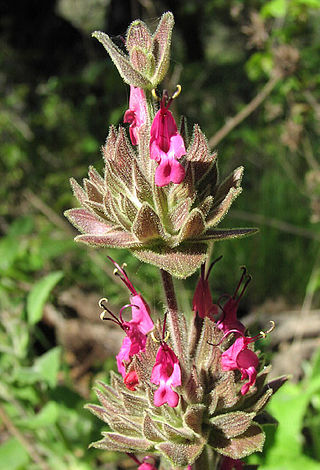
Salvia spathacea, the California hummingbird sage or pitcher sage, is a species of flowering plant in the family Lamiaceae, native to southern and central California growing from sea level to 610 m (2,001 ft). This fruity scented sage blooms in March to May with typically dark rose-lilac colored flowers. It is cultivated in gardens for its attractive flowering spikes and pleasant scent.
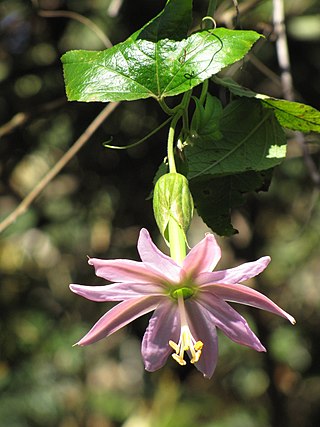
Passiflora tarminiana is a species of passionfruit. The yellow fruits are edible and their resemblance to small, straight bananas has given it the name banana passionfruit in some countries. It is native to the uplands of tropical South America and is now cultivated in many countries. In Hawaii and New Zealand it is now considered an invasive species. It was given the name banana passionfruit in New Zealand, where passionfruit are also prevalent. In Hawaii, it is called banana poka. In its Latin American homeland, it is known as curuba, curuba de Castilla, or curuba sabanera blanca (Colombia); taxo, tacso, tagso, tauso (Ecuador); parcha, taxo (Venezuela), tumbo or curuba (Bolivia); tacso, tumbo, tumbo del norte, trompos, tintin, porocsho or purpur (Peru).
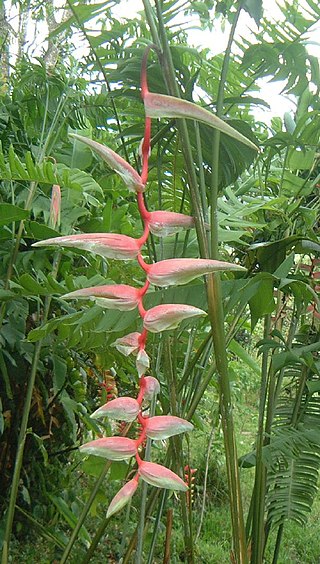
Heliconia chartacea is a species of Heliconia native to tropical South America.

The sword-billed hummingbird, also known as the swordbill, is a neotropical species of hummingbird from the Andean regions of South America. It is the only member in the genus Ensifera. Among the largest species of hummingbird, it is characterized by its unusually long bill, being the only bird to have a beak longer than the rest of its body, excluding the tail. It uses its bill to drink nectar from flowers with long corollas and has coevolved with the species Passiflora mixta. While most hummingbirds preen using their bills, the sword-billed hummingbird uses its feet to scratch and preen due to its bill being so long.

Nectar is a viscous, sugar-rich liquid produced by plants in glands called nectaries or nectarines, either within the flowers with which it attracts pollinating animals, or by extrafloral nectaries, which provide a nutrient source to animal mutualists, which in turn provide herbivore protection. Common nectar-consuming pollinators include mosquitoes, hoverflies, wasps, bees, butterflies and moths, hummingbirds, honeyeaters and bats. Nectar plays a crucial role in the foraging economics and evolution of nectar-eating species; for example, nectar foraging behavior is largely responsible for the divergent evolution of the African honey bee, A. m. scutellata and the western honey bee.

Ornithophily or bird pollination is the pollination of flowering plants by birds. This sometimes coevolutionary association is derived from insect pollination (entomophily) and is particularly well developed in some parts of the world, especially in the tropics, Southern Africa, and on some island chains. The association involves several distinctive plant adaptations forming a "pollination syndrome". The plants typically have colourful, often red, flowers with long tubular structures holding ample nectar and orientations of the stamen and stigma that ensure contact with the pollinator. Birds involved in ornithophily tend to be specialist nectarivores with brushy tongues and long bills, that are either capable of hovering flight or light enough to perch on the flower structures.
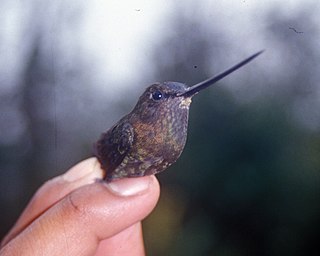
The green-fronted lancebill is a species of hummingbird in the family Trochilidae. Primarily known for its incredibly long bill and “glittering” green patch of feathers on its forehead, D. ludovicae is found in subtropical and tropical moist montane forest and prefers regions that include fast moving rivers and streams.
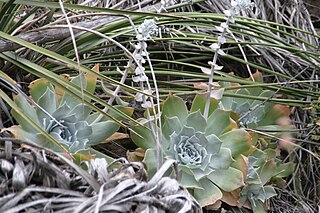
Dudleya pulverulenta is a species of perennial succulent plant known by the common names chalk lettuce, chalk dudleya, and chalk liveforever. It is one of the largest Dudleya, with a silvery, waxy rosette that may greatly contrast with its habitat. It is also regarded as one of the most distinctive members of the Dudleya, with one of the most specialized inflorescences in the genus, adapted to hummingbird pollination through its red pendent flowers, the longest corolla, and the highest nectar output. Dudleya pulverulenta has the largest range of all Dudleya, over 1,000 kilometres (620 mi), being found from southern Monterey County in California to the Sierra de San Borja in southern Baja California. It is closely related to Dudleya arizonica, a smaller desert species that tends to lack the specialized floral traits, and Dudleya anthonyi, which differs in a few morphological traits and is restricted to the San Quintín Volcanic Field.
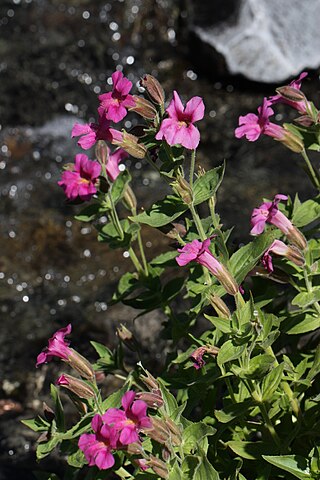
Erythranthe lewisii is a perennial plant in the family Phrymaceae. It is named in honor of explorer Meriwether Lewis. Together with other species in Erythranthe, it serves as a model system for studying pollinator-based reproductive isolation. It was formerly known as Mimulus lewisii.
This glossary of botanical terms is a list of definitions of terms and concepts relevant to botany and plants in general. Terms of plant morphology are included here as well as at the more specific Glossary of plant morphology and Glossary of leaf morphology. For other related terms, see Glossary of phytopathology, Glossary of lichen terms, and List of Latin and Greek words commonly used in systematic names.

Pachyphytum is a small genus of succulents in the family Crassulaceae, native to Mexico, at elevations from 600 to 1,500 metres. The name comes from the ancient Greek pachys (=thick) and phyton (=plant) because of the shape of the leaves.

Castilleja integra, with the common names orange paintbrush, Southwestern paintbrush, and wholeleaf paintbrush, is a partially parasitic herbaceous perennial plant native to the Southwestern United States and Northern Mexico. The species produces a relatively large amount of nectar and is attractive to hummingbirds. It is better suited to cultivation than most other species in the paintbrush genus (Castilleja) and is therefor used in xeriscape gardens and naturalistic meadows, even outside its native range.

A nectar spur is a hollow extension of a part of a flower. The spur may arise from various parts of the flower: the sepals, petals, or hypanthium, and often contain tissues that secrete nectar (nectaries). Nectar spurs are present in many clades across the angiosperms, and are often cited as an example of convergent evolution.
Thunbergia bicolor, also known as the bicolour clock vine, is a species of flowering plant within the family Acanthaceae.

















